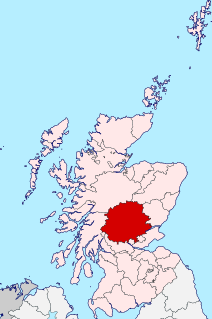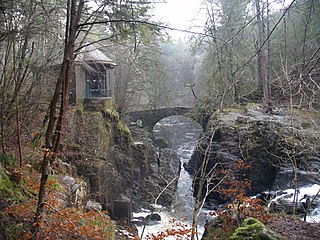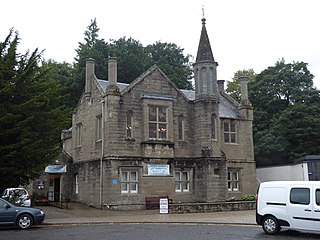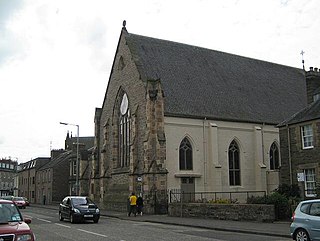
Perthshire, officially the County of Perth, is a historic county and registration county in central Scotland. Geographically it extends from Strathmore in the east, to the Pass of Drumochter in the north, Rannoch Moor and Ben Lui in the west, and Aberfoyle in the south; it borders the counties of Inverness-shire and Aberdeenshire to the north, Angus to the east, Fife, Kinross-shire, Clackmannanshire, Stirlingshire and Dunbartonshire to the south and Argyllshire to the west. It was a local government county from 1890 to 1930.

Perth is a city in central Scotland, on the banks of the River Tay. It is the administrative centre of Perth and Kinross council area and the historic county town of Perthshire. It had a population of about 47,430 in 2018.

Dunkeld is a town in Perth and Kinross, Scotland. The location of a historic cathedral, it lies on the north bank of the River Tay, opposite Birnam. Dunkeld lies close to the geological Highland Boundary Fault, and is frequently described as the "Gateway to the Highlands" due to its position on the main road and rail lines north. Dunkeld has a railway station, Dunkeld & Birnam, on the Highland Main Line, and is about 25 kilometres north of Perth on what is now the A9 road. The main road formerly ran through the town, however following modernisation of this road it now passes to the west of Dunkeld.

Dunkeld & Birnam railway station serves the towns of Dunkeld and Birnam in Perth and Kinross, Scotland. It is located on the Highland Main Line, 15 miles 31 chains (24.8 km) north of Perth and is the first stop on the line north of there. It has a passing loop 28 chains (560 m) long, flanked by two platforms. Platform 1 on the up (southbound) line can accommodate trains having twelve coaches, but platform 2 on the down (northbound) line can only hold ten. When no crossing is to be made, northbound trains are usually routed through platform 1 which is signalled for bi-directional running.
Birnam is a village in Perth and Kinross, Scotland. It is located 12 miles (19 km) north of Perth on the A9 road, the main tourist route through Perthshire, in an area of Scotland marketed as Big Tree Country. The village originated from the Victorian era with the coming of the railway in 1856, although the place and name is well known because William Shakespeare mentioned Birnam Wood in Macbeth:
MACBETH: I will not be afraid of death and bane, till Birnam forest come to Dunsinane.

Murthly is a village in Perth and Kinross, Scotland. It lies on the south bank of the River Tay, 5 miles southeast of Dunkeld, and 9+1⁄2 miles north of Perth. Perth District Asylum, later known as Murthly Hospital, was opened in the village on 1 April 1864 for 'pauper lunatics'. It was the second district asylum to be built in Scotland under the terms of the 1857 Lunacy (Scotland) Act. It closed in 1984 and was later demolished. The village has a stone circle, in the former grounds of the hospital. The village formerly had a railway station on the Perth and Dunkeld Railway, which closed in 1965.

Dunkeld Bridge is a seven-arch bridge crossing the River Tay at Dunkeld, Perth and Kinross, Scotland. It carries the pedestrian and vehicle traffic of Bridge Street and connects the parishes of Dunkeld and Dowally to the north and Little Dunkeld to the south. A Category A listed structure, it is 685 feet (209 m) long, 26.5 feet (8 m) wide and 54 feet (16 m) high. Its middle arch is 90 feet (27 m) wide, two others are 84 feet (26 m), two more are 74 feet (23 m) and the land-arches are 20 feet (6 m). The pontage was abolished in 1879.

Bridgend is a residential area of Perth, Scotland, approximately 0.25 miles (0.40 km) east of the city centre, on the eastern banks of the River Tay. It is in Kinnoull parish. A settlement has existed here since at least the 16th century.

The Hermitage Bridge is an ancient, single-arch stone pedestrian bridge crossing the River Braan near Dunkeld, Perth and Kinross, Scotland. A Category A listed structure, it is in the bounds of The Hermitage, a National Trust for Scotland-protected site. The bridge should not be confused with the Rumbling Bridge, which carries motorised traffic, about 0.62 miles (1.00 km) to the southwest.

The Taybank Hotel is a hotel and restaurant in Dunkeld, Perth and Kinross, Scotland. It is a Category C listed building dating to the early 19th century.

The Perth Arms Hotel is a hotel and restaurant in Dunkeld, Perth and Kinross, Scotland. It is a Category B listed building dating to around 1755.

Dunkeld market cross, in the Scottish town of Dunkeld, Perth and Kinross, is in the form of a drinking fountain. A Category B listed structure in the care of the National Trust for Scotland, it was designed by C. S. Robertson and erected in 1866 as a monument to the George Murray, 6th Duke of Atholl. It replaced a cross that was about 20 feet (6.1 m) high, with four iron jougs attached to it.

The Atholl Arms Hotel is a hotel and restaurant in Dunkeld, Perth and Kinross, Scotland. Standing at the corner of Bridge Street and Boat Road, it is a Category B listed building dating to 1833.

The Duchess Anne is an historic building in Dunkeld, Perth and Kinross, Scotland. Standing near Dunkeld Market Cross, it is a Category B listed building dating to 1853. It is two storeys, made of ashlar stone, and its architect was R & R Dickson.
Tay Street is a major thoroughfare in the Scottish city of Perth, Perth and Kinross. It is part of the A989. Constructed in the second half of the 19th century, it is named for the River Tay, Scotland's longest river, on the western banks of which it sits. The street runs from the confluence of West Bridge Street and Charlotte Street in the north to a roundabout at Marshall Place and Shore Road in the south. Three of the city's four bridges that cross the Tay do so in this stretch : Perth Bridge, Queen's Bridge and the single-track Tay Viaduct, carrying Perth and Dundee trains to and from the railway station, 0.5 miles (0.80 km) to the north-west.

St John the Baptist Church, also known as St John's Roman Catholic Church, is located in Perth, Perth and Kinross, Scotland. It is a Roman Catholic congregation, based on Melville Street, to the north of the city centre. Completed in 1832, it is now a Category C listed building.

North Church is located in Perth, Perth and Kinross, Scotland. Of Church of Scotland denomination, it is located on Mill Street, but its official address is 209 High Street. Completed in 1880, it is now a Category B listed building. The church's architect was Thomas Lennox Watson.

Cathedral Street is an historic street in Dunkeld, Perth, Perth and Kinross, Scotland. It connects High Street, in The Cross, to Dunkeld Cathedral. The National Trust for Scotland has restored its houses dating to the 17th and 18th centuries. Several of the buildings are original, and survived the 1689 Battle of Dunkeld.


















